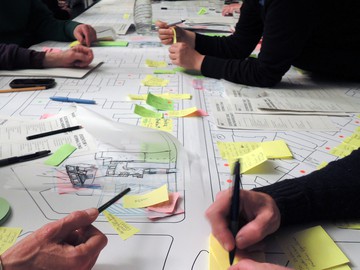Im Dissens? / In Dissent?
Nachbarschaft, Gentrifizierung und künstlerisches Engagement in der Oranienstraße
Neighbourhood, Gentrification, and Artistic Engagement in Oranienstraße
2019

Vor diesem Hintergrund gründete sich in der nGbK die Arbeitsgruppe »Im Dissens? Nachbarschaft, Gentrifizierung und künstlerisches Engagement in der Oranienstraße«. In den vergangenen Monaten recherchierte die Gruppe in der Oranienstraße zur Situation von Gewerbemieter_innen und Kulturschaffenden, Eigentumsverhältnissen und der Finanzialisierung des Mietmarktes, zur zunehmenden Verdrängung und den Möglichkeiten, sich dagegen zu wehren. In öffentlichen Workshops eignete sich die Gruppe gemeinsam mit stadtpolitisch Aktiven und Interessierten Werkzeuge für das digitale Mapping an und kartierten die Straße.
Eine der Leitfragen war dabei – auch, weil die nGbK als Kulturinstitution seit fast dreißig Jahren in der Straße ansässig ist – welche Rolle Kunst und Kultur in Gentrifizierungs-Prozessen und in Bezug zur Nachbarschaft in der Oranienstraße spielen, welche Unterschiede es zwischen den Kulturakteur_innen, Anwohner_innen und Gewerbetreibenden konkret gibt und wie man über diese hinweg solidarisch handeln kann.
Die Ergebnisse der Recherche sowie Gastbeiträge zu diesen Themen sind in der Stadtteilzeitung »Eigentum und Alltag« nachzulesen. Nach Ende des Projektes soll das digitale Mapping der Straße stadtpolitischen Initiativen und Nachbar_innen als Ressource zur Verfügung stehen.
EN:
Oranienstraße has been in a crisis for some time. The astronomical rises in rental costs have affected commercial premises as well as housing. Smaller shops are particularly feeling the pressure. For many, displacement is immanent or has already taken place, as landlords increasingly maximise their profits. These developments have led to protests and solidarity from political initiatives and the neighbourhood.
The nGbK project group »In Dissent? Neighbourhood, Gentrification and Artistic Engagement in Oranienstraße« was formed in this context. In recent months, the group has examined the situation facing commercial tenants and creative practitioners in Oranienstraße, including issues of property, the financialisation of the rental market, displacement and the possibilities to defend oneself against it. During a series of public workshops, the group worked with initiatives and interested people to appropriate digital mapping tools and to map the street.
Bearing in mind that the nGbK has been located on Oranienstraße as a cultural institution for almost thirty years, one of the key questions here was about the role that art and culture play in gentrification processes and in the neighbourhood, about the difference between cultural players, residents and retailers, and about how they can act in solidarity.
The results of the research, as well as guest contributions on its themes, will be published in a newspaper format with the title »Eigentum und Alltag« (Property and Everyday Life) and distributed locally. The project will conclude by making the digital mapping of the street available to initiatives and neighbours as a free resource.
